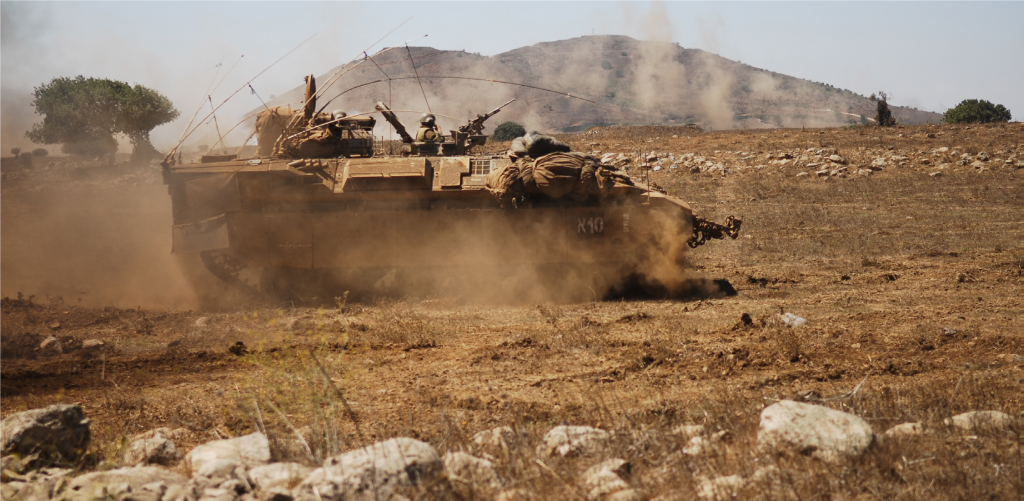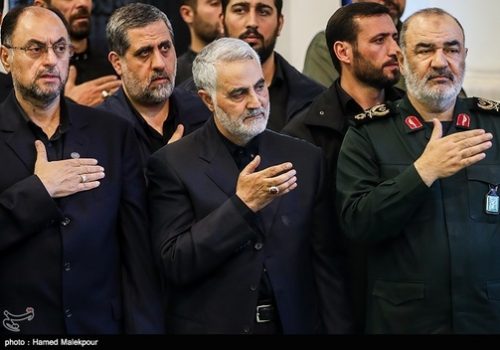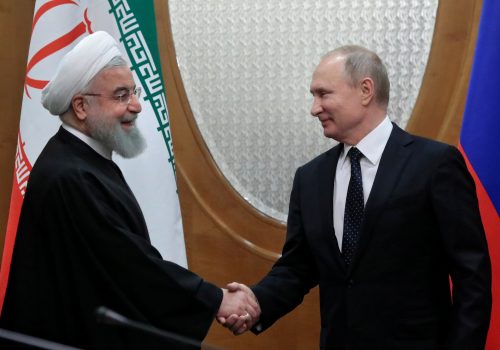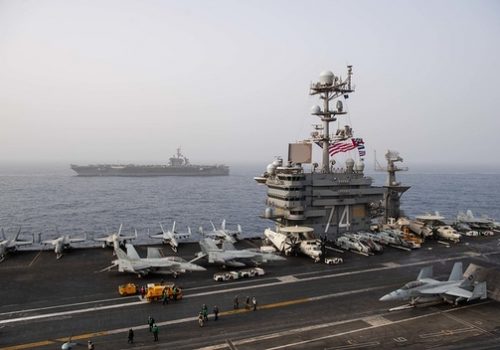Iran began its military involvement in Syria in 2011, at the outbreak of the civil war. Tehran’s immediate objective was to defeat the Syrian opposition militarily to save Syrian President Bashar al-Assad. The maintenance of the Shia-Alawi-dominated regime in Damascus was key to the Islamic Republic’s long-term regional strategy, the creation of a contiguous Shia arc of influence in the region, linking Iran through Iraq to Syria and Lebanon. The Syrian theater also witnessed changes to Iran’s traditional use of proxies, militias, and plausible deniability.
The Iranian Revolutionary Guard Corps’ Quds Force perfected its proxy doctrine during the fight in Syria, using asymmetric units as the main ground force but allowing the use of regular military units as support elements if needed. However, the Quds Force undermined and abandoned its own doctrine when it changed its strategy in Syria as victory over the opposition loomed. It began establishing permanent basing, which made its personnel, including the proxy militiamen, easy targets for Israel. The Quds Force also abandoned the doctrine when IRGC artillery units under its direct command fired rockets at Israeli front positions in the Golan, prompting massive retaliation from Israel against not only Iranian proxies and materiel, but also personnel.
Iran’s insistence on maintaining a major military presence in Syria could well put it on the brink of war on another front—with Israel on Syrian soil and beyond. This report by Scowcroft Center nonresident senior fellow Nader Uskowi explores the possibility for Iranian-Israeli conflict in Syria, as well as the way forward for the various actors involved there.
Iran began its military involvement in Syria in 2011, at the outbreak of the civil war in the country. Tehran’s immediate objective was to defeat the Syrian opposition militarily to save Syrian President Bashar al-Assad. The maintenance of the Shia-Alawi-dominated regime in Damascus was key to the Islamic Republic’s long-term regional strategy, the creation of a contiguous Shia arc of influence in the region, linking Iran through Iraq to Syria and Lebanon.
Syria was the missing link. Across the border to the west, Hezbollah, the jewel of Iran-led Shia militant organizations in the Middle East, had become the de facto ruling party of Lebanon. Across the border to the east, Iranian influence had reached its zenith in Iraq after the departure of US forces from the country, which also occurred in 2011. The outbreak of civil war gave Iran the opportunity, and the pretext, to intervene militarily in Syria. With its presence in Syria, a land corridor could be built linking Shia enclaves from Iran to the Levant, acting as the symbol and enabler of the Islamic Republic’s influence in the region.
The Islamic Republic was also following another long-term strategy, establishing a military presence at the borders of Israel. From the early years of the Islamic Revolution, Iranian leaders had publicly called for the destruction of the Jewish state. In fact, they named their Revolutionary Guard’s expeditionary army the Quds (“Jerusalem”) Force, to be the vanguard for “liberating” Jerusalem. Deployment of Iranian forces and Iran-led Shia militia groups to Syria—under the command of the Quds Force—first intended to save Assad. But the Iranians were to parlay their victory against the opposition into a permanent presence in the country, only tens of kilometers from Israel’s northern front. The Quds Force-led groups in Syria were to be used in any future military conflict with Israel.
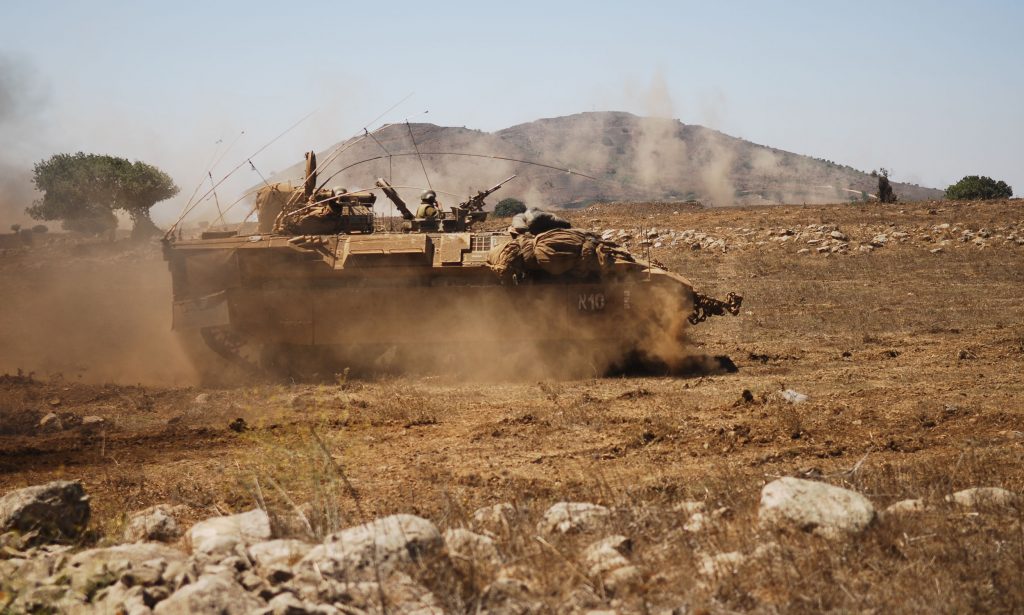
At the height of the civil war, the Quds Force deployed nearly 80,000 Shia militiamen into Syria to fight the opposition,1Zeina Karam, “Analysis: Iran role in Syria key item at Trump-Putin summit,” AP, July 13, 2018. including fighters from Hezbollah, major Iraqi Shia militant groups, and Afghan and Pakistani Shia militias, commanded by nearly 2,000 Islamic Revolutionary Guard Corps (IRGC) and Quds Force officers. In December 2016, Aleppo fell to the Quds Force-led, pro-regime forces, marking the virtual defeat of the opposition. Iran had achieved its immediate objectives. The opposition was on the run and Assad was safe.
But Iran did not evacuate its personnel and the militias under its command from the country. It actually began establishing permanent command and control and intelligence centers across the country and leased parts of several dozen Syrian military bases to house its personnel, weapons, and installations. A Quds Force general officer, arguably the anointed successor to General Soleimani—the commander of the Quds Force—now heads the combined Iranian and foreign militia forces in Syria, numbering in tens of thousands of fighters. Israel is calling for this force’s complete withdrawal from Syria.
Crossing “red lines”
After the victory in the Battle of Aleppo, Quds Force commanders put their focus on a multi-faceted, post-conflict strategy. The first component of the strategy is establishing permanent basing in Syria to house Quds Force personnel and the foreign Shia militias under its command. The Iranian installations in those bases include general headquarters, regional command and control centers, intelligence cells, UAV battalions and runways, weapons and heavy equipment depots, and other logistics facilities.2Anna Ahronheim, “Before and After Images Show Israeli Strikes on Iranian Base,” Jerusalem Post, May 13, 2018.
The second component is constructing plants to upgrade rocket and missile arsenals of the Shia militia groups stationed in Syria, particularly those of Lebanese Hezbollah. This effort is part of a Quds Force campaign to extend the range and increase the accuracy of rockets and missiles used by the militias under its command, a campaign dubbed the “Precision Project.”3“Precision Project,” aka “Accuracy Project” refers to Iranian missile factories built in the region to upgrade Hezbollah’s rockets and missiles for their accuracy and range. See, Gross, Judia Ari, “Report sheds light on Iranian missile factories being built in Lebanon,” Times of Israel. July 9, 2017.
The third is expanding logistics facilities to move personnel, weapons, and equipment into Syria, including facilities at Damascus International Airport and other airfields in Syria, and transition facilities at the Iraq-Syria border as part of the “land corridor” for movement of heavier equipment and larger formations of personnel on land to Syria.
Finally, the fourth is securing the land corridor on both sides of the Iraq-Syria border by permanently positioning battalions of Shia militias at selected crossing points.
In achieving its initial objectives in Syria, Iran crossed all Israeli “red lines.” Israel considers the permanent deployment of a large force under the command of the Quds Force in Syria a direct threat to its security. Upgrading Hezbollah’s rockets and missiles poses a significant and immediate threat to Israel. Expanding weapons shipment to Syria means a better equipped Iran-led force in Syria and a better-equipped Hezbollah in Lebanon, both serious threats to Israel. And finally, the permanent establishment of a land corridor from Iran to Syria and Lebanon would enable Iran to supply its forces via a land route complementary to its existing air bridge, and as an alternative to the air bridge should Damascus airport and other Syrian airfields be taken out in case of a direct military conflict between Iran and Israel on Syrian soil. Israel repeatedly and publicly communicated its red lines for the Quds Force and major actors involved in the Syrian conflict to take notice, and Iran and its proxies repeatedly challenged them.
Not just a change in strategy, but doctrine too
The Quds Force perfected its proxy doctrine during the fight in Syria. In the preparation phase, battalions of Shia militia organizations were deployed near the battlefield. Quds Force officers were embedded in their units to provide operational and tactical leadership. If needed, elements from Iran’s regular militaries—the IRGC and Artesh—were deployed on temporary duty to a given area to provide specialized support—artillery, armor, UAV, and special forces. To soften the opposition defenses, the Quds Force used its firepower. Then the militia battalions staged offensives and remained in the battlespace to complete the cleanup operations. The doctrine used asymmetric units as the main ground force but allowed the use of regular military units as support elements if needed. It also allowed maximum flexibility as the fighting forces were gathered on temporary duty at the battlespaces, which would not pin them down as fixed targets for an extended period of time, and the fighters could be entirely or partially redeployed to other battlefronts as the war developed. Due to heavy use of proxies, the Quds Force could also resort to deniability if a particular operation did not progress as planned.
Avoidance of direct military conflict with a superior force and masking Iranian participation with the use of proxies underpinned this doctrine. However, the Quds Force undermined and abandoned its own doctrine when it changed its strategy in Syria after its victory over the opposition. It began establishing permanent basing, which made its personnel, including the proxy militiamen, easy targets for Israel. The Quds Force also abandoned the doctrine when IRGC artillery units under its direct command fired rockets at Israeli front positions in the Golan.4Farzin Nadimi, “Iran’s Miscalculated Escalation in the Golan,” The Washington Institute for Near East Policy, May 10, 2018. The Iranians essentially began to disregard their own historically tested preference for fighting in a “gray zone.”

Unsurprisingly, the Israelis began hitting the Iranian fixed installations set up in dozens of Syrian military bases, and the Israeli attacks forced the Iranians to retaliate when seemingly unprepared to engage the Israeli military. Iran’s new strategy exposed its forces to the Israelis, and any major retaliation would have required their readiness to directly engage a superior military force on foreign soil, for which the Iranians were not prepared. Within the span of few short months, the Iranians were parlaying their undisputed victory over the opposition to eventual defeat by a superior force due to their lack of preparedness to engage such an enemy on foreign soil.
The Israelis hit back
On May 10, 2018, the IRGC missile battalion deployed to Syria under the command of the Quds Force fired more than thirty rockets toward Israeli military installation in the Golan Heights. The rocket fire was a retaliatory action by Iran against an earlier Israeli attack on the IRGC’s drone facilities at the Tiyas (T-4) air base in Syria. Among the systems used by the Iranians were the Grad, a 122-mm multiple-launch rocket system, and larger 333-mm Fajr-5 rockets. Reportedly, only four rockets reached the border and were intercepted by the Israeli air defense batteries.5Farzin Nadimi, (2018). The Israelis hit back in massive, disproportionate, and coordinated air and missile strikes against nearly all Iranian command and control and intelligence facilities, the IRGC’s UAV command system, Iranian logistics centers, weapons depots, and military compounds.6Morris Loveday, Ruth Eglash, and Louisa Loveluck, “Israel launches massive military strike against Iranian targets in Syria,” Washington Post, May 10, 2018. By its action, Israel showed its determination to prevent the Iranian military from entrenching itself in Syria and establishing a permanent presence in the country so close to the Israeli northern front.
Any proportionate retaliation could have started a full-fledged war between the two countries on Syrian soil and beyond, an eventuality for which the Iranians were not prepared.
Iran did not retaliate against the massive Israeli strikes. Any proportionate retaliation could have started a full-fledged war between the two countries on Syrian soil and beyond, an eventuality for which the Iranians were not prepared. Although Iran would not voluntarily evacuate its forces from Syria—marginalizing its role not just in Syria but across the Middle East—it halted its buildup near Israeli front positions in Golan to avoid being dragged into a major war.
Iran’s Syria strategy: the context
The lack of Iranian response to the Israeli attack did not take place in a vacuum. The reason the Iranians were uncharacteristically hesitant to engage the Israelis could have been the rapidly worsening economic and political situation back home, raising questions about the long-term financial and internal political viability of keeping a large expeditionary force in Syria only as a check against the Israeli presence in the area. Also, the Iranian armed forces were facing a potential showdown with regional and global powers over the attempted control by their proxies on the Yemeni coast of the all-important Bab el-Mandeb, the major tanker chokepoint in the region. These concerns, of course, do not mean that the Iranians had given up on their dreams in Syria.
Ayatollah Khomeini, the founder of the Islamic Republic, told all who wanted to listen that the 1979 revolution was not about Iran, but the whole Middle East. Four decades later, Iran’s Islamists can point to generally successful Iranian military involvements in Syria, Iraq, and Yemen as the triumph of Khomeini’s vision. From Afghanistan and Pakistan through Iran, Iraq, and the Levant, the Islamic Republic has established an arc of influence linking Shia enclaves across the Middle East. And Syria plays a major role in this project. Ironically, after all the success in the region, the Islamic Republic is beginning to face existential challenges at home and in its near abroad.
The economy is at a standstill, with the national currency, the rial, in free fall.7“Iran currency extends record fall as US sanctions loom,” Reuters, July 29, 2018. Popular resentment at the government’s inability to resolve economic hardship has spilled onto the street, with waves of protests in many Iranian cities and towns waged this year questioning the ability of the regime to continue on for long.
The challenges in the near abroad are as daunting. Declarations by Iran’s civilian and military leaders that the US-imposed oil sanctions would force the country to disrupt the flow of oil from the region’s chokepoints—the Strait of Hormuz in the Persian Gulf and Bab el-Mandeb in the Red Sea—are bringing the country to the brink of war with major actors in the region.
It is against this background, looming economic and political instability at home and military challenges elsewhere in the region, that the Quds Force should define its way ahead in Syria. On the political and economic front, Quds Force operations have become increasingly unpopular. Billions of dollars are spent annually by the government on its Syria project, which is hard to justify to the Iranian people when the country is facing an economic meltdown.
On the regional front, the Iranian insistence on maintaining a major military presence in the country could well put Iran on the brink of war on another front—with Israel on Syrian soil and beyond. The Iranian military is stretched too thin to conduct kinetic operations simultaneously against major actors from the Persian Gulf to the Bab el-Mandeb to Syria.
The way ahead in Syria
Iran’s strategy in Syria needs to be calibrated against those of its competitors and foes in the theater and coordinated with those of its allies. In this section we will look at Iran’s main objectives in Syria and will sum up the strategies of the other main actors that Iran has to react to. The Quds Force’s objectives in post-civil war Syria could be summed up as following:
- Projection of power by continued presence in Syria, especially to the Shia communities across the region, signifying that Iran is actively engaged in safeguarding Shia interests in the near abroad;
- A permanent presence close to the Israeli northern front as a counterbalance to Israel’s power and influence in the area;
- Capability to maintain the land corridor, linking its forces in Syria to its supply base in Iran;
- Freedom of movement for its forces and those Shia militant organizations under its command, particularly Lebanese Hezbollah; and
- Placement of Iran’s allies and proxies within Syrian state security institutions, including its National Defense Forces (NDF) and its internal security apparatus, based on their experience with the Popular Mobilization Forces (PMF) in Iraq.
On a tactical level, the Iranians expect the United States to withdraw its forces from Syria soon, giving them the opportunity to move along with their militias in territories left by the United States, in the Euphrates River Valley and northeast Syria.
The Quds Force’s objectives in post-conflict Syria are different from or opposed to the strategies and interests of other major actors. Hence, as the country’s current conflict abates, new conflicts loom on the horizon.
Israel’s strategy
Israel has repeatedly warned that it will not allow Iran and the Shia militia forces under its command to establish a permanent presence in post-conflict Syria.
Assad’s forces have already entered southwestern Syria and the Syria-controlled Golan Heights. The presence of Iran-led forces, including Lebanese Hezbollah, alongside the Syrian forces near Israeli front positions is particularly unacceptable to Israel.
But Israel’s concerns are not limited to the Iranian presence near its northern front. In fact, on July 23, Israeli Prime Minister Benjamin Netanyahu rejected a Russian offer to establish a 100-km (62-mile) buffer zone for Iran-led forces along the Israel-Syria border, saying the offer did not go far enough.8MEMO, “Netanyahu rejects Russia offer to keep 100km away from Israel,” Middle East Monitor, July 25, 2018. Netanyahu wants to stop the Iranians from establishing a permanent military presence anywhere in Syria.
Other Israeli strategic objectives include stopping the flow of Iranian advanced weaponry to Syria and through Syria to Lebanon, and dismantling Iran’s “Precision Project” plants, where Quds Force technicians are upgrading Hezbollah’s rockets and missiles for better accuracy and longer range. Israel also wants all long-range Iranian missiles and air defense systems deployed to Syria to be removed.
A mere 100-km buffer zone between Iranian forces and the Israeli front positions does not prevent Iran from undertaking anti-Israeli efforts in Syria. Iran could still deploy and fire longer-range missiles and rockets outside the buffer zone. Its missile upgrade facilities could still be housed outside the zone. And, as importantly, the Quds Force could still base its personnel and tens of thousands of Shia militias at Syrian bases also outside the buffer zone. The combination of these capabilities, even if the 100-km separation were to hold, would still be a serious threat to the Israeli security.9Raphael Ahren, “Israel Rejects Russian offer to keep Iran 100 km from Syrian border,” Times of Israel, July 23, 2018.
“Our opinion is known that Iran needs to leave Syria,” Netanyahu said during his latest trip to Moscow to discuss Iran’s role in Syria with Russian president Vladimir Putin.10Zeina Karam, “Analysis: Iran role in Syria key item at Trump-Putin summit,” AP, July 13, 2018.
Russia’s strategy
Since 2015, when Russia began its direct military intervention in Syria, Russia’s objective has been the full restoration of the Assad regime’s control to the entire country. That goal is finally being realized, with the Sunni opposition all but losing the war, and the Kurds seemingly ready for a compromise with Damascus.
Post-conflict Syria still figures to be dotted with foreign armies with differing and at times conflicting objectives. It is in such an environment that the Kremlin has emerged as an uncontested power broker in Syria. Now, Russia needs to find a way to navigate among its allies, competitors, and adversaries in Syria, including Iran, Israel, Turkey, the United States, and the remnants of the opposition forces.
The Russians believe that expecting Iran to fully withdraw from Syria is unrealistic. Their latest proposal for establishing a 100-km buffer zone between Israeli and Iran-led forces was an attempt at compromise. But the offer was not one the Israelis could accept.
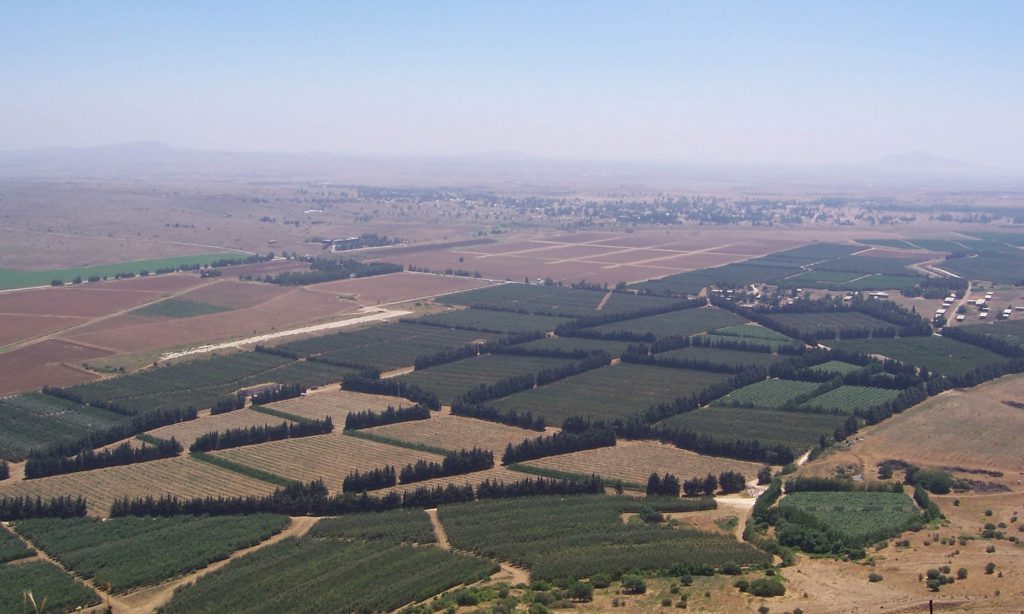
Russia is not Israel’s enemy, in Syria or elsewhere. In fact, during frequent Israeli air and missile attacks against Iranian military personnel and installations inside Syria, including the massive May 10 attacks against almost all Iranian sites in the country, the Russians did not use their S-400 air defense system to intercept Israel’s incoming missiles.11David Makovsky, “Putin’s Golan Comments: Implications for Israeli Security,” Washington Institute for Near East Policy, July 18, 2018.
Russia and Iran’s interests in Syria also do not always converge. The Russians could even consider Iran as a competitor, and not an ally, in Syria.
At the height of the civil war, the Russians needed the Iranians and their proxies to provide ground forces in support of the Assad regime. The Quds Force-led ground forces probably played a more critical role in defeating Assad’s opposition than did the Russian Air Force. But Assad’s dependence on Iranian forces diminished as the fighting wound down. Putin and Assad can now afford to limit the Iranian presence in Syria, and the worsening economic situation inside Iran will make it less useful to a post-conflict Assad regime.
Still, Moscow has made it clear that it will not abandon Iran altogether and will not push the Iranians to completely withdraw their forces from Syria; hence, its buffer zone proposal to manage Iranian influence but not end it.
The US position on Iran’s presence in Syria also makes Russia’s strategy that much more complicated. The United States has reportedly told the Russians that American forces will remain in Syria as long as the Iranians are present there too.12Patrick Goodenough, “Bolton: US Troops Will Remain in Syria ‘As Long As the Iranian Menace Continues,” CNSNews.com, July 16, 2018. That’s a prospect that neither Assad nor Russia would like to see. But the Russians, like the Iranians, apparently believe that—Washington’s public proclamations notwithstanding—the Americans will leave Syria sooner than later.
This exercise of strategic patience would also serve Russia’s other major objective: establishing a permanent military presence of its own in Syria, complete with naval and air bases.
Turkey’s strategy
Turkey’s main goal in Syria is to counter Kurdish ambitions and to create an autonomous Kurdish state: less emphasis on Assad, more on the Kurds. Toward that end, Turkey will be ready to form strategic or tactical alliances to crush an independent or autonomous Kurdish region on the border, and is ready to see the Assad regime take control of Rojava, the Syrian Kurdistan.
The Kurds, concerned with the departure of their backer, the United States, from Syria, and fearing an all-out military assault by the Turks after the American departure, might want to directly negotiate with Assad to save what is left of their Rojava project and the future of an autonomous Kurdish region in post-conflict Syria.
The American strategy
The United States entered Syria to fight the Islamic State of Iraq and al-Sham (ISIS), beginning at Kobane in 2014 and continuing its campaign to defeat ISIS at all its strongholds in the country, including Raqqa. Throughout, the People’s Protection Units (YPG)-led Syrian Kurds and their Arab allies provided the ground forces for the US counter-ISIS campaigns. The victory of the United States and its Kurdish allies over ISIS begged the question of the future role of US forces in Syria and the future of their alliance with the Kurds.
The victory over ISIS in Syria did not happen in a vacuum. Other state and non-state actors also entered the Syrian theater pursuing their own objectives. None of those forces had declared a voluntary departure from Syria. The Iranians show no intentions of leaving, nor do the Russians, nor the Turks. Internally, many issues are unresolved. The Kurds still insist on some form of autonomy for Rojava. Opposition forces in Idlib are threatened by Syrian and Iran-led forces. The humanitarian situation in the country is still at crisis level. The issues of the return of hundreds of thousands of Syrian refugees and internally displaced persons are still not resolved. The massive need for reconstruction of the country is still unplanned. An early departure of US forces from Syria will leave these issues unresolved, and will give other actors, like the Iranians and their militias, the opportunity to fill the territories and the vacuum left by the departure of their forces.
A post-ISIS, post-conflict Syria—still dotted with foreign armies and non-state actors—calls for a new US strategy. The continued presence of small but agile US military units in Syria could actually help usher a political settlement in the country. The United States’ stated policy of linking the departure of American forces to that of the Iranians and their proxies is a major step in the right direction. Leaving Syria and letting Iran, Hezbollah, and extremist Shia militia groups occupy land that was ruled by ISIS until recently is in effect allowing Shia extremists to replace Sunni extremists. That could not have been the goal of the US counter-ISIS campaign. Shia extremism is as dangerous as Sunni extremism not only for Syria, but for the entire region. Our interests and those of our allies do not recognize differences between Shia and Sunni extremism; they feed off one another, and the dominance of one is often the breeding ground for the other.
Recommendations on the way ahead
Notwithstanding differing and opposing interests in Syria, a deal to normalize the situation in the country could still be possible, with each actor having its own reasons to accept a compromise by taking the following steps:
- The Iranians are facing tremendous challenges at home and in the near abroad and could be ready for compromise, probably sooner than others, if a face-saving arrangement can be found. Such an arrangement could include Iran keeping a cadre of military advisers in the country to show, especially to the Shia communities in the region, that they have not abandoned Syria. As for their Shia militias, the Iranians could insist that Hezbollah still operate in areas near the border with Lebanon as an extension of their defensive strategic depth. The other foreign militants—the Iraqis, Afghans, Pakistanis, and others—could be redeployed to their countries or back to Iran.
- The Russians would keep their naval base at Tartus13Damien Sharkov, “Vladimir Putin Has Big Plans for Russia’s Naval Base in Syria – Including Staying Until 2092.” Newsweek, December 14, 2017. and the air base at Hmeimim14“Russian airbase in Syria: RT checks our everyday life at Latakia airfield,” RT, October 3, 2015., which are both located in the coastal province of Latakia, Assad’s powerbase. The military bases would provide Russia a strategic gateway to the Middle East nearly three decades after the collapse of the Soviet Union.
- The Israelis will keep the Syrian army presence at Syrian-controlled Golan in check, something they have been able to achieve since the 1974 Agreement on Disengagement (aka Separation of Forces Agreement) with Syria.15The Avalon Project, “Separation of Forces Agreement Between Israel and Syria, May 31, 1974,” Yale Law School. They would also see the majority of Iran-led forces out of Syria.
- The Turks and Kurds will struggle to define the status of the Kurdish region in post-conflict Syria. The Kurds would need Assad’s and Russia’s backing after the United States’ departure to maintain a degree of autonomy in the region that was once their Rojava project. In fact, the Kurds, wary of US departure, would draw their own conclusions and begin formal and unconditional talks with the regime in the hope of securing an autonomous Kurdish region in Assad’s Syria.16Ellen Francis, “Wary of US ally, Syrian Kurds look to Damascus for talks,” Reuters, July 25, 2018.
- The Americans, eager to get out of Syria, could point to Israeli acceptance of the compromise and their avoidance of a quagmire.
- But above all, a political settlement for internal forces should be found, and guaranteed by major powers, so the majority-Sunni refugee population could return home with guarantees of protection from reprisals by Assad regime forces. In this way, a campaign to reconstruct the war-torn country could start.
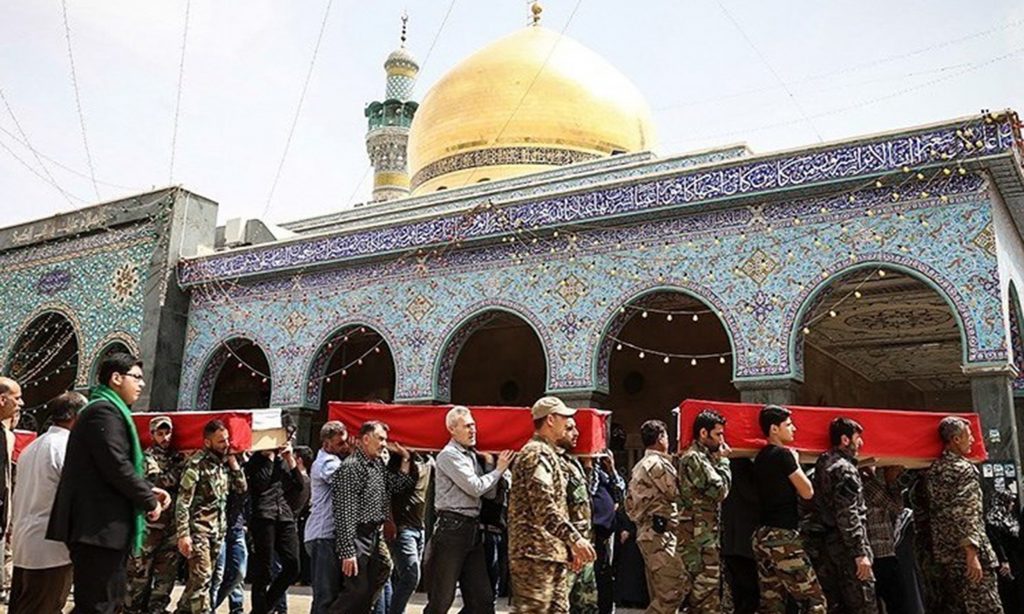
The alternative to this or other compromises will be costly.
The Iranians, after spending billions of dollars, seeing hundreds of Quds Force officers and thousands of Shia militants killed in action, and fearing the loss of political power in the Shia world, could balk at any compromise. Yet keeping forces in Syria will expose them to Israeli attacks, as the Israelis will continue insisting that Iran pull all the forces under its command out of Syria. Under such circumstances, a full-fledged war between Iran and Israel on Syrian soil and beyond probably becomes inevitable, an unattractive outcome for either side.
Further reading:
Image: The 13th Battalion of the Golani Brigade during a drill held in the Golan Heights in northern Israel. Photo credit: Wikimedia Commons
